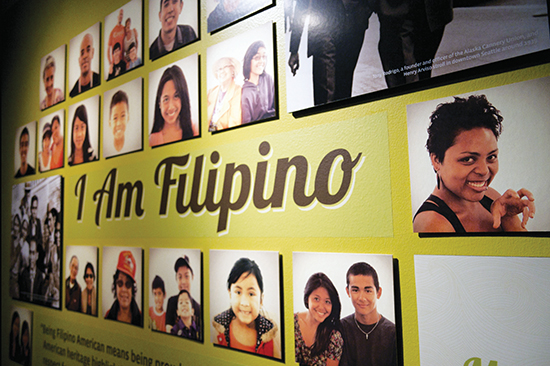
A photo mural of Filipino Americans featured in the exhibit. (Photo by Charles Lam/NWAW)
By Shin Yu Pai
NORTHWEST ASIAN WEEKLY
The Filipino American identity has been a fixture at the Wing Luke Museum for over a year and is looking for community input.
The “I Am Filipino” exhibition installed in The Wing Luke Museum’s Community Portrait Gallery celebrated a full year of being on display in March. The exhibition, originally organized by Cynthia Mejia-Giuduci and a community advisory board that included Ethelynn Abellanosa, Ron Angeles, Rus Bareng, Pio de Cano, Jr., Dorothy Cordova, Carmen Español, Carmel Laurino, Gina Gevero O’Neill, and Stacey Swanby explores the many aspects of Filipino American identity through a multi-media interactive gallery experience. Conceived in collaboration with The Wing’s exhibitions staff, I Am Filipino seeks to both dynamically represent and help build upon the narrative of the Filipino experience through inviting visitors to contribute and archive their own experiences.
Mejia-Giudici first approached The Wing Luke Museum in 2009, hoping to organize a photo exhibition in tandem with a conference of the Filipino American National Historical Society (FANHS) scheduled to take place at Seattle University. However, because the museum plans its shows several years in advance, Mejia-Giudici was forced to postpone her vision for a display. Later, a museum staff member encouraged her to submit a formal proposal for a broader exhibition that could be installed in the Community Portrait Gallery.
Mejia-Giudici’s idea for a show was to present historical and factual information about the Filipino experience. In her work as an educator at Roosevelt High School, she had encountered numerous Filipino American students who identified as Filipino, but didn’t have a real understanding of their heritage.
I Am Filipino sought to address this gap by presenting the historical challenges faced by Filipino Americans.
A color photo installation featuring diverse and multi-generational images of Filipino Americans fills one wall of the gallery. Drawn from dozens of photos taken at the annual Pista sa Nayon Festival at Seward Park in 2011 and loaned by the FANHS, the photo mural provides a wide view of Seattle’s ever-evolving Filipino community. Quotes reflecting upon the nature of Filipino identity fill out the display. A central quote reads, “It’s hard to say what being Filipino is. It can be anything. For me personally, it is about prioritizing family and laughing as much as you can.”

The Filipino immigration timeline (Photo by Charles Lam/NWAW)
Mejia-Giudici hopes that as the exhibition continues, photographs from the mural can be exchanged to reflect images of visitors to the show. The photo wall is complemented by an interactive computer station in the gallery that allows gallery-goers to scroll through slideshows shared by other visitors.
“We’ve had more than 50 photo submissions since we opened the exhibit in March 2012, in addition to the more than 125 photos we collected during Pista sa Nayon and more than 25 photos collected at the Filipino Community Center Christmas Party in December 2011,” said Jessica Rubenacker, exhibits specialist at The Wing.
In addition to sharing photos, visitors are encouraged to record oral histories of friends and family members speaking on their experiences of being Filipino American. Three thematic listening stations installed in the gallery feature nearly a dozen oral histories that explore topics of Filipino American history, Filipino identity, and culture and community. Mejia-Giudici hopes that the oral histories installed on the listening stations will be refreshed over time with new recordings.
“So far, we haven’t had anyone conduct an oral history yet,” said Rubenacker. “But there is a woman who plans to come in to interview her father, who is one of the last surviving vets from the Bataan Death March in the area.”
A display mounted on an interior wall provides a timeline and history of the different waves of immigration from the Philippines to the United States, drawing from the work of Fred Cordova, founding president of FANHS. Beginning with the first wave prior to 1906, the historical overview identifies four major migrations, tracking immigration patterns up to 1965 and the present day. Prominent Seattle-area Filipinos are highlighted throughout the timeline, including Dolores Sibonga — the first Filipina American to serve on the Seattle City Council, Velma Veloria — the first Filipina American state legislator, Bob Santos, and Alex Tizon and Byron Acohido — two Pulitzer-award winning journalists for the Seattle Times.
One last wall provides a small space where visitors can creatively express their experience of the exhibition and what being Filipino American means to them. Mejia-Giudici hopes to see the space expanded, so that visitors can continue to make the exhibition theirs, creating their own “I Am” statements using graffiti, notes, and pictures that enlarge the space and add their voices to what it means to be Filipino.
“They have a disconnect with the Filipino community,” Mejia-Giudicci said. “Just because we don’t speak Tagalog doesn’t mean we’re not Filipino.” (end)
“I Am Filipino” is one of several exhibitions currently installed in The Wing’s Community Portrait Gallery. Other exhibitions include Alaskero: A Documentary Exhibit on Pioneer Filipino Cannery Workers; Vietnam in the Rearview Mirror; and additional displays on the Sikh and Khmer cultures. For more information, visit www.wingluke.org/exhibitions/special.htm.
Shin Yu Pai can be contacted at info@nwasianweekly.com.



